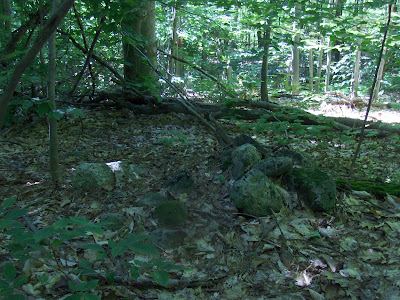 There was something quite similar over by Scott Reservoir in Fitchburg, in a similar topographic setting - looking southeast over a body of water.
There was something quite similar over by Scott Reservoir in Fitchburg, in a similar topographic setting - looking southeast over a body of water.Can we look at some of these pictures (you'll need to click on some of the photos)? I want to say that these seem to have some structure of larger cobbles arranged in relation to each other and in relation to smaller cobbles. Here is a closeup of the first pile I glimpsed through the bushes:
 Here the big cobbles form the beginning of an outline. Clearly a rock pile with a hollow but with some additional structure to the side. What about this one? A rock pile connected to larger cobbles in some kind of arrangement:
Here the big cobbles form the beginning of an outline. Clearly a rock pile with a hollow but with some additional structure to the side. What about this one? A rock pile connected to larger cobbles in some kind of arrangement: Not a great example of anything but let's keep going. Here we see something like a rectangular outline with larger rocks in the middle:
Not a great example of anything but let's keep going. Here we see something like a rectangular outline with larger rocks in the middle: Here is another small pile with a hollow and some larger rocks to the side:
Here is another small pile with a hollow and some larger rocks to the side: Here is a nice example. Almost like a little bit of stone wall with a smeared rock pile next to it:
Here is a nice example. Almost like a little bit of stone wall with a smeared rock pile next to it: Here is another one, not very clear. But look at the shape of the larger cobbles sitting on top of the shape of the smaller ones.
Here is another one, not very clear. But look at the shape of the larger cobbles sitting on top of the shape of the smaller ones. Here is another smaller outline connected to structure.
Here is another smaller outline connected to structure. Do you agree the structure is observable? This site is somewhere roughly where the lower blue outline is on this map fragment.
Do you agree the structure is observable? This site is somewhere roughly where the lower blue outline is on this map fragment. They also built massive walls around here:
They also built massive walls around here: This rock pile site also had a few piles built on larger support boulders. Here, I guess the structure is more representational than functional.
This rock pile site also had a few piles built on larger support boulders. Here, I guess the structure is more representational than functional.  I should explain that rock piles with hollows are quite grave-like. Unlike sites with large mounds where graves would imply higher status individual burials. At this site the interpretation is of a more egalitarian collection of burials. Also, the sites with large mounds have small satellites piles and here there were none. But there were effigies on boulders.
I should explain that rock piles with hollows are quite grave-like. Unlike sites with large mounds where graves would imply higher status individual burials. At this site the interpretation is of a more egalitarian collection of burials. Also, the sites with large mounds have small satellites piles and here there were none. But there were effigies on boulders.
1 comment :
I want to ask a basic question: is this Algonquian?
Post a Comment